Protecting Our Oceans through Partnerships
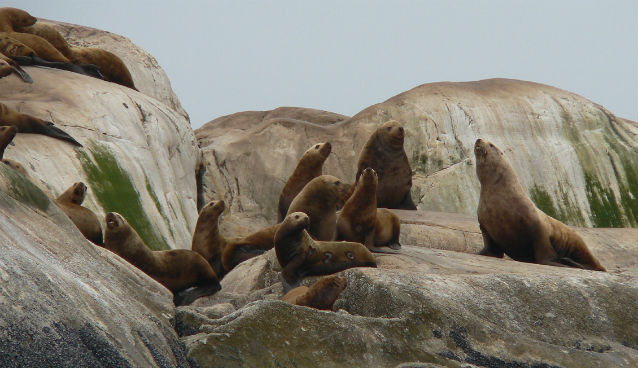
NPS
May 2000 marked a milestone increasing the protection of ocean resources through cooperative management. The National Ocean Policy directed federal agencies to work with states, territories, tribes, regional fishery management councils, and nongovernmental partners to develop and maintain a National System of Marine Protected Areas (MPA) in the U.S. An MPA is defined as “any area of the marine environment that has been reserved ... to provide lasting protection for part or all of the natural and cultural resources therein.” In the past decade, the National MPA Center has become a leader world-wide, in the advancement of marine protection, management and education.
The vision of this MPA system is to have “an effective, science-based, and collaborative national system of marine protected areas conserving U.S. marine ecosystems and their associated natural and cultural resources,” with a mission to “facilitate the effective use of science, technology, training, and information in the planning, management, and evaluation of the nation’s system of marine protected areas.” An important objective of the MPA Center is fostering “awareness and understanding of the national system and place-based ecosystem-based management.”
For the National Park Service, the initial focus has been to inventory all ocean and coastal parks in the system and nominate them for inclusion into the national system of MPAs. More than 1,700 sites have been identified nationally; 300 have been included. In the Pacfic West Region, twenty ocean parks qualify and 10 have been included in MPAs. A great example of cooperation has been in California where 107 MPAs are represented on the national list, largely due to the state of California’s efforts establishing a state-wide network of MPAs.
The Pacific coast national parks are coordinating on specific areas through Coastal Marine Spatial Planning (CMSP). CMSP is a way to organize the protection and use of marine resources through an integrated and adaptive approach to the development, use and conservation of the marine and coastal environment to achieve social and economic objectives. Hand in hand with CMSP are efforts to adaptively manage for the potentially profound effects of climate change on marine ecosystems. National Parks along the Pacific Coast, in collaboration with NOAA and other agencies, are planning for climate change impacts to our oceans; addressing these threats through an ecosystem-based, adaptive approach. Find out more about your MPAs here.
Dr. Sarah Allen, PWR Ocean Stewardship Coordinator
Conservation through Cooperation

Channel Islands National Park was established in 1980 to protect the five northern Channel Islands and their offshore waters out to one nautical mile. The waters extending six nautical around each island are part of Channel Islands National Marine Sanctuary. Nearly half of the park lies underwater and encompasses one of the most diverse marine environments in the world. The living marine resources in the park and sanctuary are managed by the state of California. The National Park Service and the National Oceanic and Atmospheric Administration are charged with monitoring ecosystem health and recommending actions to protect the systems. Fishing is allowed in park and sanctuary waters, consistent with state regulations.
When existing policies do not succeed in maintaining fish population size and community structures, information from park science programs helps scientists and managers design new strategies to protect the marine ecosystems.
An important part of conservation at the Channel Islands is monitoring the health of the marine environment. The protection and stewardship of marine resources requires baseline information, which can then be used to understand how an ecosystem naturally varies over time. Monitoring allows scientists and resource managers to detect significant changes in the ecosystem and to assess the success of various management actions.
California’s Ocean Parks
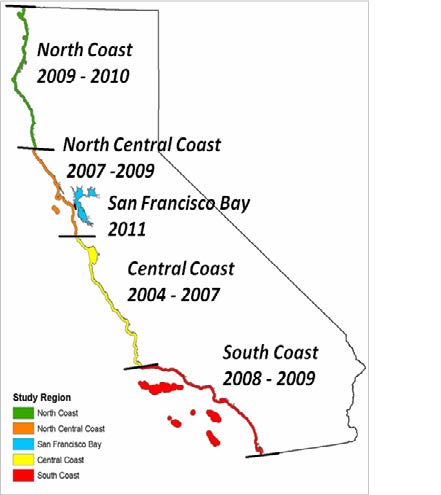
Over the past decade, several National Parks in California have participated in an innovative state-wide effort to establish a network of Marine Protected Areas (MPAs.) In 1999, the State of California enacted the Marine Life Protection Act (MLPA) to improve the design and management of MPAs in state waters. The goal was to increase their effectiveness in protecting the state’s marine life, marine ecosystems, and heritage.
The focus of the MLPA is on marine ecosystems and habitats rather than single species, and requires the state resource agencies to create a network of MPAs that 1) uses the best readily available science, 2) involves stakeholders, 3) bases decisions on six goals (see here), and 4) engages a science advisory team to inform and guide decisions.
Stakeholders included local fishermen, recreationists, environmentalists, business owners and federal resource managers. Together these groups proposed potential MPA networks. In the process, they contributed local expertise and knowledge, conducted outreach to constituent groups, and collaborated to reach agreement. The effort was painful but successful in presenting proposed MPA networks that met most of the guidelines and goals of the MLPA.
A science advisory team established by the partnership was tasked with 1) determining habitats and species likely to benefit from MPAs, 2) defining levels of protection needed to restore or protect marine life populations based on particular species being removed with specific gear types, and 3) designing guidelines on size, spacing, and habitat representation and replication to ensure that MPAs can be managed as a network. The design of MPAs was tied to ecological factors such as habitat type (rocky vs. sandy), fish size, home ranges, and larval dispersal.
The collaborative process was intended to apply design guidelines for an effective network of MPAs. It took into account important issues such as boater safety, proximity to harbors, as well as ecological considerations. The preferred MPA proposals from each region were evaluated through the state planning process and approved by the California Fish and Game Commission.
The MPA classifications include three discrete types: state marine conservation area which allows some recreational and/or commercial extractive activities; state marine park which allows some recreational activities but prohibits all commercial extractive activities; and state marine reserve which prohibits all extractive activities. Several marine reserves have been identified in California national parks, including at Channel Islands National Park where a reserve at Anacapa Island has been in place for more than five years.
Monitoring the effectiveness of the MPAs is essential. Five years after the MPAs were established at the Channel Islands scientists discovered that there were bigger fish inside the reserves than outside. This suggests that the MPAs are having a positive effect as bigger fish produce exponentially more eggs. Research has found egg production is approximately 3.5 times higher inside reserves versus outside. The network of MPAs at Point Reyes National Seashore were just implemented in 2010 and will require more years of study to determine if they also are having a positive benefit.
Special thanks to Dr. Mark H. Carr, Department of Ecology and Evolutionary Biology, University of California, Santa Cruz
Dr. Sarah Allen, Pacific West Region, Ocean Stewardship Coordinator, and Melissa Miller-Henson, Program Manager, California MLPA Initiative
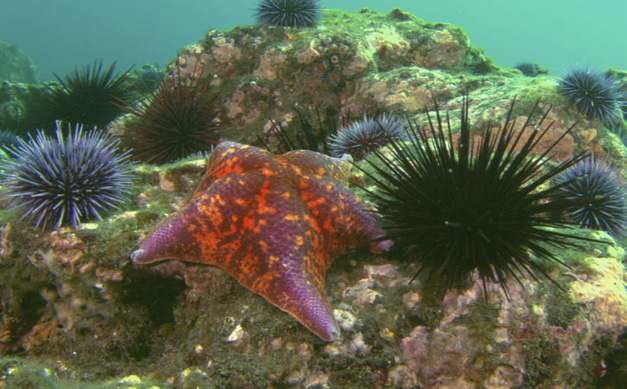
NPS
Early Monitoring Indicates Positive Trends in Reserves
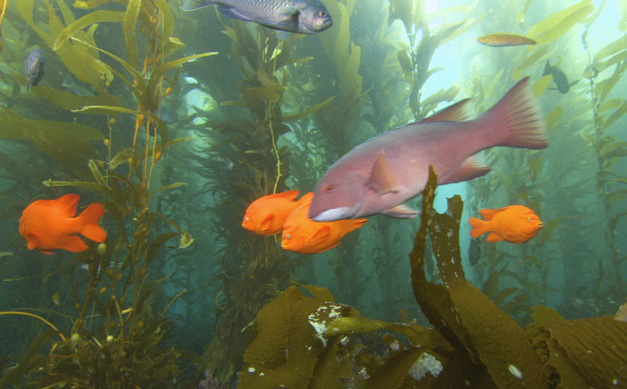
NPS
Following the establishment of the Channel Islands marine reserve network in 2003, the National Park Service doubled the number of kelp forest monitoring sites to better test the effects of the reserves. Monitoring data will provide information needed to address important questions such as: 1) Will marine reserves reverse declines in marine species and restore ecosystem health? and 2) Are other actions needed to protect marine ecosystems?
Research results published following the first five years of monitoring the new marine reserves were at the Channel Islands indicated some positive trends including
• Greater overall number of fish and diversity of species inside reserves versus outside.
• Larger average size of some species like kelp bass and spiny lobster inside marine reserves.
• Kelp beds around the Channel Islands have recently increased, after experiencing substantial declines in the 1980s and 1990s.
These studies found that there are bigger fish, more fish, and more kinds of marine species, inside the reserves than outside. The increase in the average size of some species can be important because larger fish produce exponentially more young than smaller fish. Studies of the movement of tagged fish species showed that some are remaining in the reserves for significant portions of time, thereby gaining protection from the reserves. Socioeconomic findings have shown that the number of recreational fishing charter boat trips has stayed fairly constant since the marine reserves were established.
The California State Fish and Game Commission intends to review monitoring data from the Channel Islands every five years. Scientists expect it to take a long time to detect significant change in the marine reserves due to the inherent variability of the kelp forest ecosystem. Long-term monitoring will continue to be a valuable tool for managers to make informed decisions in their evaluation of marine reserves as a method to restore and sustain ocean resources.
A New Tool To Sustain Our Ocean Resources
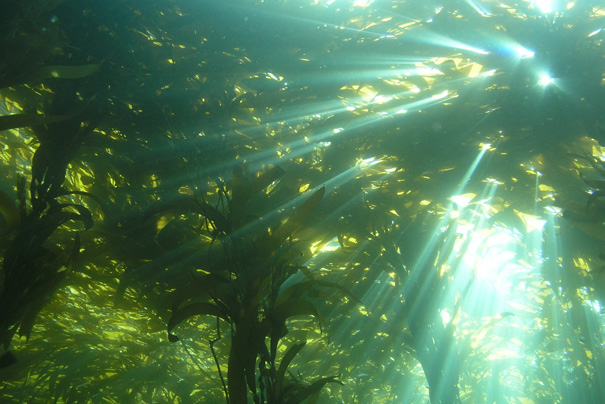
NPS
It is widely recognized that ocean resources are declining worldwide. Major threats to ocean systems include pollution, overdevelopment, ocean warming, and overfishing. In some parks, like the Channel Islands, marine reserves have been established in an effort to restore and sustain fisheries and improve ecosystem health.
The kelp forests at the Channel Islands are one of the most productive ecosystems on earth. They are an important part of California’s economic, cultural, and natural history. Like tropical rainforests, these towering seaweeds provide structure, food, and hiding places for more than 1,000 species of plants and animals, providing necessary habitat for species as diverse as giant black sea bass and tiny blue-banded gobies.
Kelp forests are influenced by both natural events and human activities. Strong storms and increased water temperature associated with El Niño events can cause dramatic changes in kelp forest communities. Human activities also affect the health and survival of kelp forests through coastal development, sedimentation, pollution, and fishing. Removal of predators can alter the predator-prey balance in kelp forests ecosystems. For example, with sea otters absent at the Channel Islands, when spiny lobster and California sheephead are overharvested, herbivore populations like purple sea urchins increase and decimate kelp beds through overgrazing. These areas transition into “barren” landscapes supporting relatively few species. Loss of kelp beds also eliminates nursery grounds for many species whose young live in the kelp until they are large enough to venture into open waters. Without shelter and food from the kelp forest, these populations may be dramatically reduced.
To conserve this marine ecosystem a network of Marine Protected Areas (MPAs) that restrict and/or prohibit harvest in the waters surrounding the Channel Islands National Park and Channel Islands National Marine Sanctuary was established by NOAA and the California State Fish and Game Commission. These thirteen MPAs cover 318 square miles or about 20 percent of the park waters. They are meant to protect habitats, rebuild depleted fisheries, conserve biodiversity, provide a refuge for sea life, and enhance recreational and educational opportunities.
One type of MPA is a marine reserve, a new tool in marine ecosystem management, where all forms of take, such as fishing, are prohibited. The goal of most marine reserves is to increase the abundance and diversity of marine life inside their borders. Currently, less than one percent of the world’s oceans and less than 0.01 percent of U.S. waters are designated as marine reserves.
The Channel Islands marine reserves were championed by a consortium of commercial and recreational fishers, agencies, and non-profit organizations in hopes that they will help reverse fishery declines and promote recovery of kelp forest ecosystems. Marine reserves have been established by many other countries as part of a larger effort to protect, conserve, and restore ocean resources worldwide.
Contributors
Dr. Sarah Allen, PWR Ocean Stewardship Coordinator
Yvonne Menard, Channel Islands National Park
Editors:
Bonnie Phillips, Cabrillo National Monument
Jim Pfeiffenberger, Kenai Fjords National Park
Nichole Andler, Pinnacles National Monument
John Dell’Osso, Point Reyes National Seashore
Part of a series of articles titled Pacific Ocean Education Team (POET) Newsletters.
Previous: POET Newsletter Summer 2010
Next: POET Newsletter May 2012
Last updated: October 8, 2021
